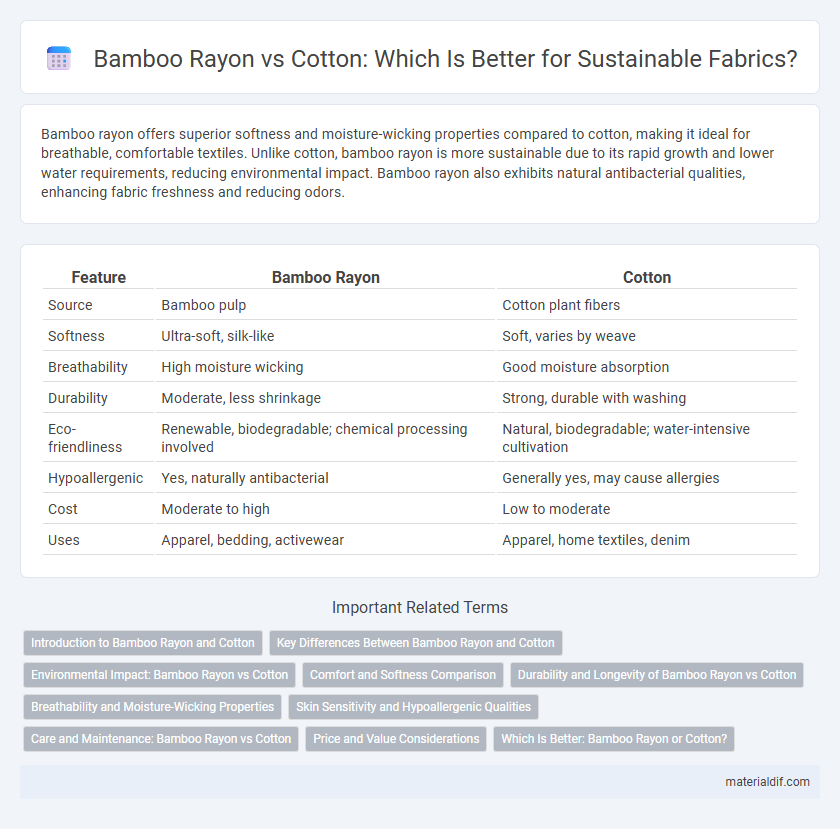Bamboo rayon offers superior softness and moisture-wicking properties compared to cotton, making it ideal for breathable, comfortable textiles. Unlike cotton, bamboo rayon is more sustainable due to its rapid growth and lower water requirements, reducing environmental impact. Bamboo rayon also exhibits natural antibacterial qualities, enhancing fabric freshness and reducing odors.
Table of Comparison
| Feature | Bamboo Rayon | Cotton |
|---|---|---|
| Source | Bamboo pulp | Cotton plant fibers |
| Softness | Ultra-soft, silk-like | Soft, varies by weave |
| Breathability | High moisture wicking | Good moisture absorption |
| Durability | Moderate, less shrinkage | Strong, durable with washing |
| Eco-friendliness | Renewable, biodegradable; chemical processing involved | Natural, biodegradable; water-intensive cultivation |
| Hypoallergenic | Yes, naturally antibacterial | Generally yes, may cause allergies |
| Cost | Moderate to high | Low to moderate |
| Uses | Apparel, bedding, activewear | Apparel, home textiles, denim |
Introduction to Bamboo Rayon and Cotton
Bamboo rayon is a semi-synthetic fiber made from bamboo pulp, offering exceptional softness, breathability, and moisture-wicking properties compared to traditional cotton. Cotton, a natural fiber cultivated from the cotton plant, is valued for its durability, versatility, and widespread availability in textile production. While cotton provides good absorbency and comfort, bamboo rayon stands out due to its eco-friendly production process and antibacterial characteristics.
Key Differences Between Bamboo Rayon and Cotton
Bamboo rayon is derived from the cellulose of bamboo plants through a chemical process, offering breathability and moisture-wicking properties superior to traditional cotton fibers. Cotton, a natural fiber harvested from cotton plants, tends to provide greater durability and a softer texture but can retain moisture more than bamboo rayon. The environmental impact of bamboo rayon production varies, often involving chemicals, whereas cotton cultivation typically requires significant water and pesticide use.
Environmental Impact: Bamboo Rayon vs Cotton
Bamboo rayon production significantly reduces water consumption compared to conventional cotton farming, requiring up to 75% less water and minimizing soil degradation. Cotton cultivation relies heavily on pesticides and fertilizers, contributing to soil and water pollution, whereas bamboo grows quickly without chemical inputs, promoting sustainable land use. The chemical process used to produce bamboo rayon can generate pollution if unmanaged, but advancements in closed-loop processing are mitigating environmental harm.
Comfort and Softness Comparison
Bamboo rayon boasts a natural softness that surpasses cotton, offering a silk-like texture ideal for sensitive skin and all-day comfort. Its moisture-wicking properties enhance breathability, keeping wearers cooler and drier compared to traditional cotton fabrics. Bamboo rayon's hypoallergenic features provide an additional layer of comfort, making it a preferred choice for allergy-prone individuals seeking soft, breathable textiles.
Durability and Longevity of Bamboo Rayon vs Cotton
Bamboo rayon fibers exhibit higher durability compared to cotton due to their natural strength and resistance to wear and tear, maintaining fabric integrity over extended use. Unlike cotton, bamboo rayon resists shrinkage and pilling, contributing to the longevity of garments and household textiles. This enhanced durability makes bamboo rayon a preferred choice for eco-conscious consumers seeking long-lasting, sustainable fabric options.
Breathability and Moisture-Wicking Properties
Bamboo rayon offers superior breathability compared to cotton due to its micro-gaps and micro-holes, which enhance air circulation and keep the skin cooler. Its moisture-wicking properties excel by quickly absorbing sweat and drying faster than cotton fibers, reducing discomfort and odor buildup. These characteristics make bamboo rayon an ideal choice for activewear and warm climates where moisture management is essential.
Skin Sensitivity and Hypoallergenic Qualities
Bamboo rayon is highly favored for sensitive skin due to its natural hypoallergenic properties, reducing irritation and allergic reactions compared to cotton. Unlike conventional cotton, bamboo fibers possess inherent moisture-wicking and antibacterial qualities that help maintain skin health and prevent rashes. These features make bamboo rayon an ideal textile choice for people with eczema, dermatitis, or other skin sensitivities.
Care and Maintenance: Bamboo Rayon vs Cotton
Bamboo rayon fabric requires gentle washing in cold water and air drying to maintain its softness and prevent shrinkage, while cotton is more durable and can withstand higher temperatures during washing and drying. Bamboo rayon is naturally antibacterial and moisture-wicking, reducing odor and the need for frequent washing compared to cotton, which may retain odors more easily. Careful handling of bamboo rayon extends its lifespan, whereas cotton benefits from straightforward maintenance and long-term resilience.
Price and Value Considerations
Bamboo rayon often carries a slightly higher price than cotton due to its eco-friendly production process and biodegradability, making it a sustainable choice despite the cost difference. Cotton tends to be more affordable and widely available, but it may require more water and pesticides during cultivation, impacting its overall environmental value. Evaluating price against durability, softness, and environmental impact reveals bamboo rayon as a premium investment for long-term value in sustainable textiles.
Which Is Better: Bamboo Rayon or Cotton?
Bamboo rayon offers superior moisture-wicking and antibacterial properties compared to cotton, making it ideal for activewear and sensitive skin. Cotton, known for its breathability and durability, is a more sustainable option when organic, but conventional cotton often consumes significant water and pesticides. Choosing between bamboo rayon and cotton depends on preferences for softness, environmental impact, and fabric performance.
Bamboo Rayon vs Cotton Infographic

 materialdif.com
materialdif.com